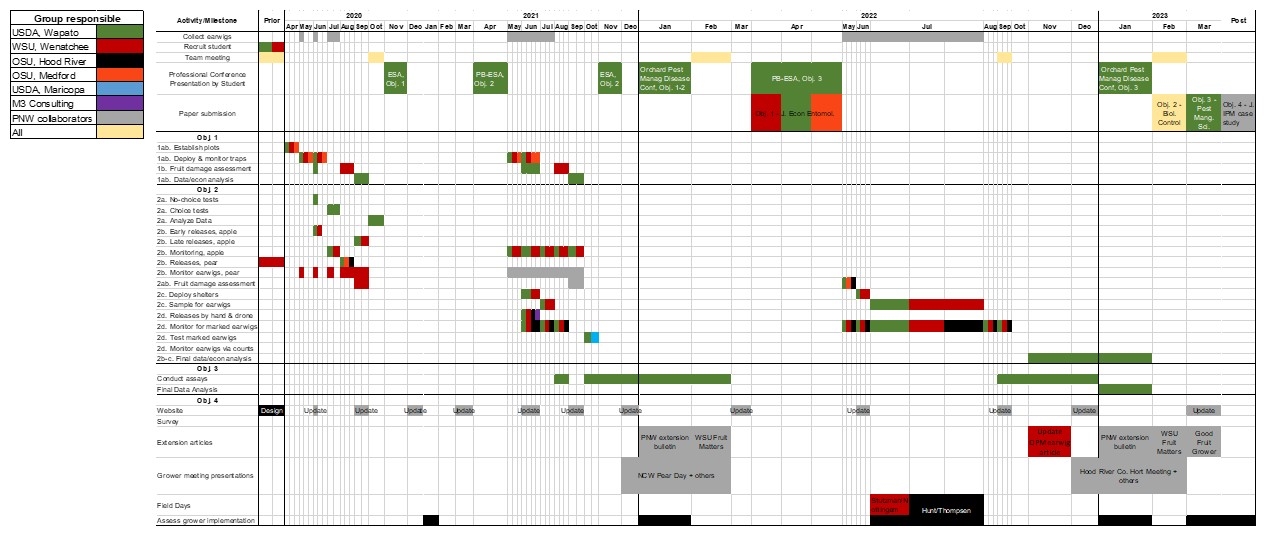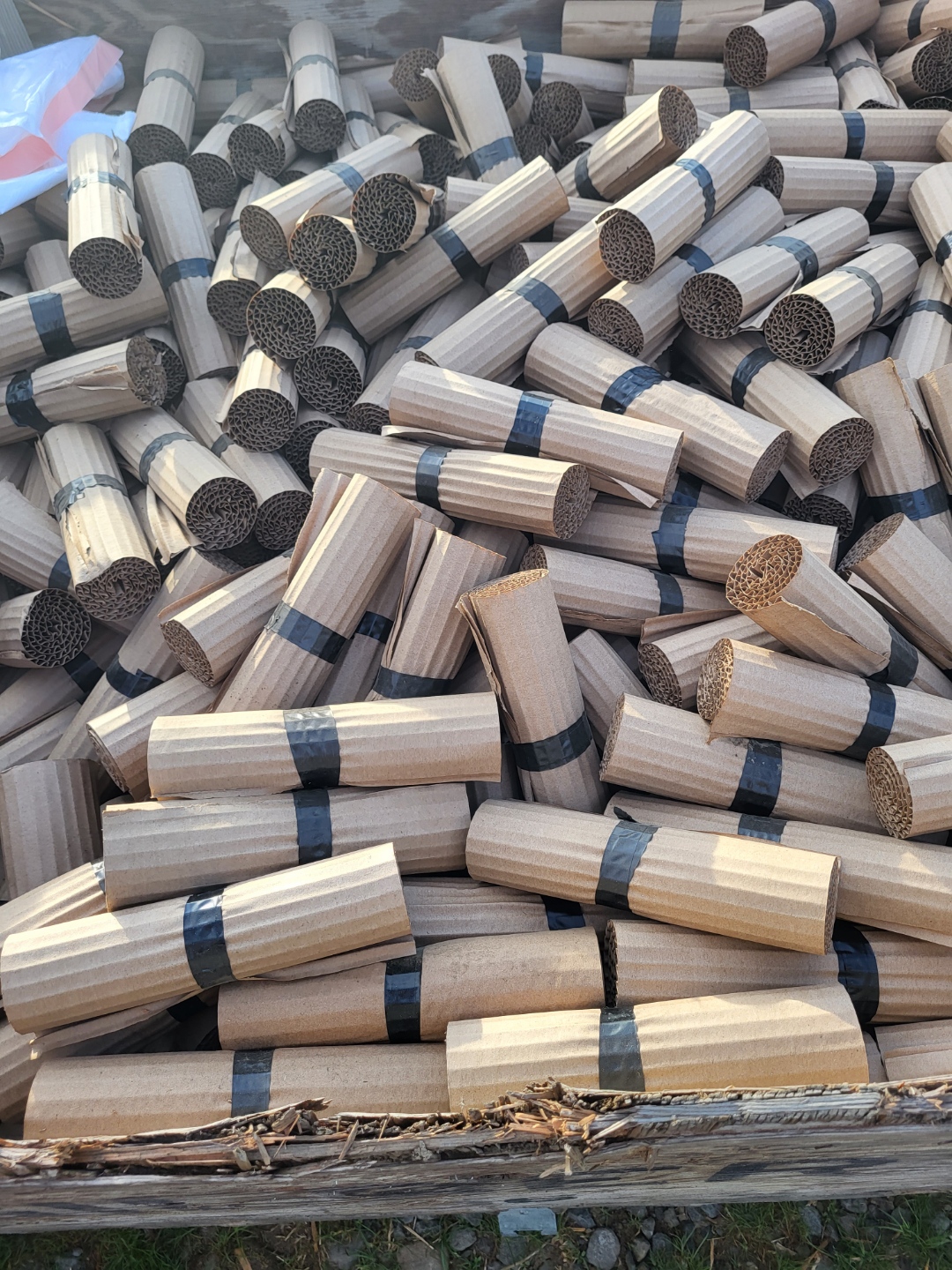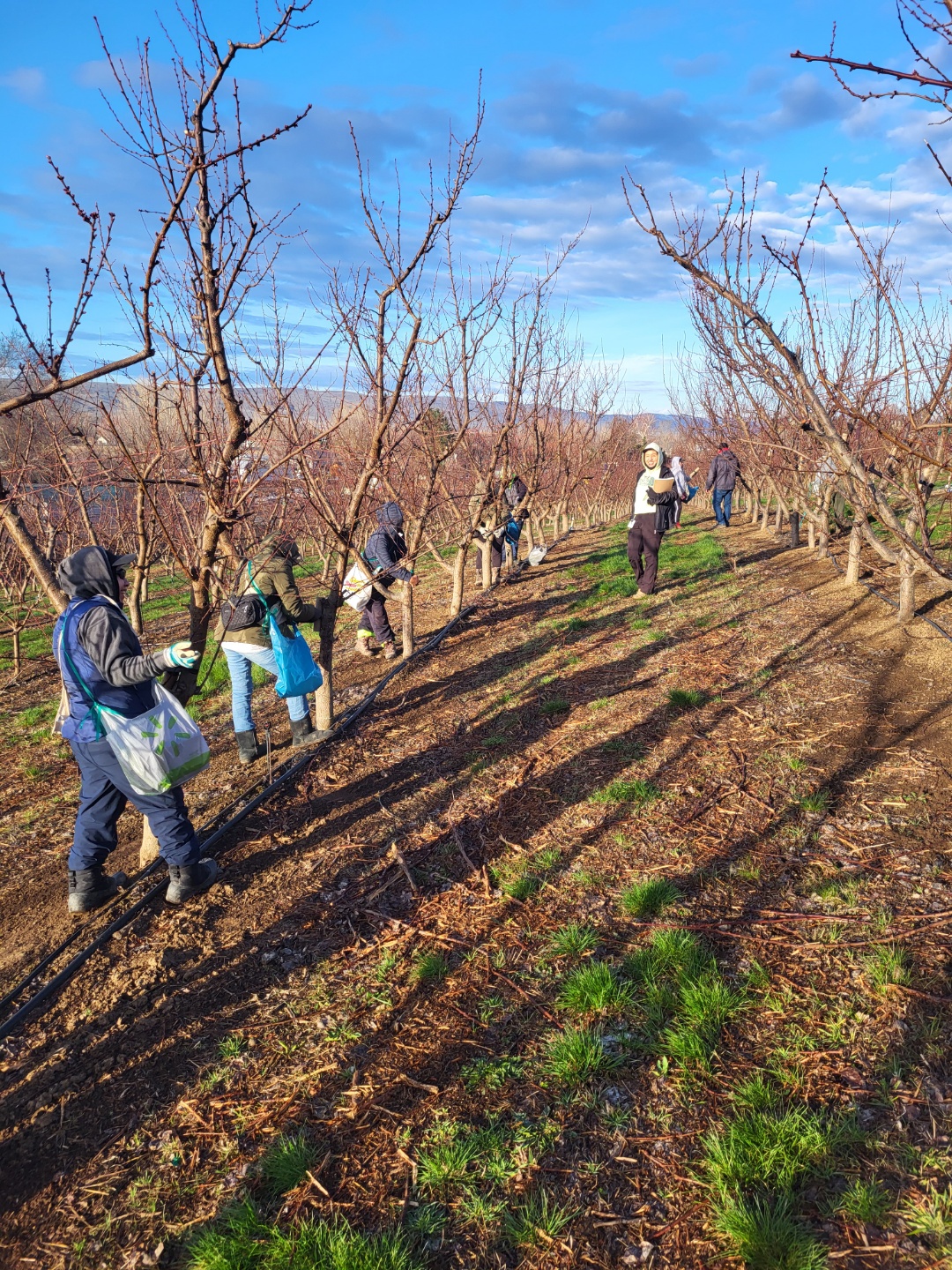Final report for SW20-916
Project Information
Current research indicates that earwigs are critical natural enemies of aphids, pear psylla, and codling moth. However, the role of earwigs in controlling orchard pests has been unappreciated, likely because previous pesticide programs were too harsh for earwigs to thrive. Growers that recently converted to softer programs have been unable to use earwig biological control because their populations have been eliminated; earwigs have long generation times and poor dispersal ability, which inhibits their reestablishment. This project will develop tactics that growers can use to inoculate their orchards with earwigs. Earwigs are particularly good candidates for inoculation because they are omnivorous and poor dispersers, so they often remain in orchards feeding on alternative food when pest populations are low. This is in contrast to other natural enemies (e.g. ladybeetles and lacewings) that readily move out of orchards after release, especially if prey populations are low. We will create a mass-trapping protocol for earwigs to support releases in pome fruit by determining (a) the most effective mass trap and (b) whether these traps can be used to reduce damage in stone fruit, where earwigs are pests. The project will examine the potential of earwig augmentation in pome fruit by (a) confirming that earwigs do not damage pears or ‘Honeycrisp’ apples, (b) determining optimal earwig release rates and timings for establishment, (c) examining efficacy of using earwig shelters to increase earwig populations, and (d) testing the potential of drones as a more efficient method of earwig release. We will also screen pesticide non-target effects on earwigs so growers can make spray choices that minimize harm to biocontrol agents. We will improve stakeholder knowledge regarding earwig IPM by (a) summarizing research findings at grower meetings, (b) conducting field days on collaborating grower farms, and (c) creating extension documents and (d) a multimedia library describing earwig biology and management. Our project will reduce orchardist reliance on insecticides to manage pests, decreasing pesticide exposure of workers, consumers, and the environment.
1. Develop a mass trapping protocol for earwigs to support releases in pome fruit by removing them from stone fruit orchards where they are pests. (Years 1-2)
a. Determine which trap type catches the largest number of earwigs in stone fruit orchards
b. Measure success of earwig mass trapping in stone fruit orchards
2. Examine potential of earwig augmentation in pome fruit.
a. Determine if earwigs cause damage to pears or to ‘Honeycrisp’ or ‘Gala’ apples (Year 1)
b. Determine optimal release rates and timing to establish augmented earwigs (Years 1-3)
c. Examine the efficacy of adding shelters to increase abundance of existing earwig populations (Years 2-3)
d. Test potential of using drones to release earwigs (Years 2-3)
3. Screen non-target effects of pesticides on earwigs. (Years 2-3)
a. Determine acute short-term toxicity of organic and conventional tree fruit pesticides to earwigs
b. Examine sublethal effects of pesticides on earwig motor coordination and predation
4. Improve stakeholder knowledge on earwig IPM.
a. Summarize research findings at grower meetings (Years 2-3)
b. Conduct field days on collaborating grower farms to demonstrate earwig monitoring and effects on pest populations (Year 2)
c. Create widely available extension documents describing earwig biology, monitoring, and augmentation (Years 1-3)
d. Create an online video and photo library to convey project results and demonstrate earwig trapping and augmentation (Years 1-3)
e. Measure changes in grower knowledge with surveys throughout the project (Years 1-3)
Please view the attached Gantt chart for the timeline (Excel version). It can also be viewed in the image below. For in-orchard work, the grower collaborators associated with each group are Nick Willett (Wapato/Yakima), Floyd Stutzman (Wenatchee), and Steve Hunt (Hood River). The research/educator leaders for each group are Rebecca Schmidt-Jeffris (Wapato), Louis Nottingham and Tobin Northfield (Wenatchee), Ashley Thompson (Hood River), Rick Hilton (Medford), James Hagler (Maricopa), Nathan Moses-Gonzalez (M3 Consulting).
Timeline of grant activities.Cooperators
- (Researcher)
- - Producer
- - Producer
- - Producer
Research
Experimental hypothesis for each objective
Develop a mass trapping protocol for earwigs to support releases in pome fruit by removing them from stone fruit orchards where they are pests.
Determine which trap type catches the largest number of earwigs in stone fruit orchards
H: Larger traps in protective plastic that have been left in the orchard for a longer period of time will catch the most earwigs
Measure success of earwig mass trapping in stone fruit orchards
H: Removal of earwigs from stone fruit orchards will decrease damaged fruit
Examine potential of earwig augmentation in pome fruit.
Determine if earwigs cause damage to pears or to ‘Honeycrisp’ or ‘Gala’ apples
H: Earwigs will only cause damage to pears and apples if they are not provided with other food sources
Determine optimal release rates and timing to establish augmented earwigs
H: At least one release rate or timing will show increased earwig abundance and reduced pest numbers compared to the no-release control
Examine the efficacy of adding shelters to increase abundance of existing earwig populations
H: Plots with shelters will have higher earwig counts than those without shelters
Test potential of using drones to release earwigs
H: Earwigs released by drone will be recovered after release at the same rate as those released by hand
Screen non-target effects of pesticides on earwigs
Determine acute short-term toxicity of organic and conventional tree fruit pesticides to earwigs
H: Some pesticides will increase earwig mortality
Examine sublethal effects of pesticides on earwig motor coordination and predation
H: Some pesticides will alter earwig movement patterns and predation rates
We were unable to start work in 2020 due to COVID-19 restrictions, so in all objectives, "Year 1" in our timeline is now 2021.
Objective 1a – Testing different types of trap to improve earwig capture
To determine if different designs of the commonly used cardboard rolled strip might capture more earwigs, we conducted field trials in stone fruit orchards in three locations in 2021: Yakima, WA, Wenatchee, WA, and Medford, OR and two locations in 2022 (dropping Wenatchee). Each individual tree contained one trap attached slightly under the tree crotch using flagging tape. Using a completely randomized experimental design, four different types of traps were tested across the three field trials in 2021, with an extra treatment being tested in only one orchard (Table 1). Because the soda shelter traps caught very few earwigs in 2021, in 2022 we focused our sampling efforts only on testing frequency of changing the trap. For each field trial, the number of earwigs per trap was counted weekly by blowing air into traps and counting earwigs that fell out of the trap into a bucket. After counting, earwigs were removed from the field and taken back to the laboratory for use in other experiments.
Table 1. Description of trap types and testing conditions
|
Treatment |
Replicates |
Trap changing frequency |
Locations |
|
Standard cardboard rolled strip (10x30cm) |
20-26 |
Monthly or when damaged |
Yakima, Wenatchee, Medford |
|
Standard cardboard rolled strip (10x30cm) |
20-26 |
Weekly |
Yakima, Wenatchee, Medford |
|
Soda shelter (0.5L) + 1 standard cardboard rolled strip (10x30cm) |
20-26 |
Monthly or when damaged |
Yakima, Wenatchee, Medford |
|
Soda shelter (0.5L) + 1 standard cardboard rolled strip (10x30cm) |
20-26 |
Weekly |
Yakima, Wenatchee, Medford |
|
Soda shelter (2L) + 4 standard cardboard rolled strips (10x30cm) |
13 |
Monthly or when damaged |
Yakima |
The data were analyzed using a linear mixed effects model (LME) using the package lme4 (Bates et al. 2015), with treatment and time (and their interaction) as fixed factors and replicate as a random factor. All data analysis was conducted using the software R, version 4.1.2 (R Core Team 2021).
Objective 1B – Mass trapping earwigs where they are pests: does it help reduce earwig populations and fruit damage?
Mass removal of earwigs
To determine if mass removing earwigs from orchards reduced their populations over time, we monitored and captured earwigs using standard cardboard traps (Fig. 1). The experiments were conducted in two commercial orchards (nectarine and cherry), located respectively in Yakima and Benton County, WA in 2021-2022. The experiment consisted of six and five 16-tree (4x4) replicates on nectarines and cherries, respectively. Each individual tree contained one cardboard trap attached slightly under the tree crotch using flagging tape. Each replicate was spaced 30m from each other to account for possible within-season dispersal of earwigs. We had two treatments: a control where earwigs were counted weekly and returned to their respective trees, and a removal treatment where earwigs were counted weekly and removed from the orchard. Weekly sampling went from May to August, and was always performed during the morning.
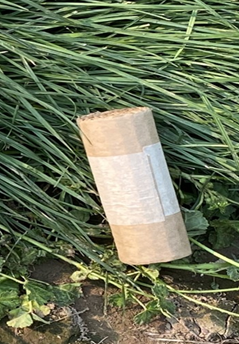
The data were analyzed using a linear mixed effects model (LME) using the package lme4 (Bates et al. 2015), with treatment and time (and their interaction) as fixed factors and replicate as a random factor. All data analysis was conducted using the software R, version 4.1.2 (R Core Team 2021).
Earwig damage
To determine if mass removing earwigs from stone fruit orchards reduced fruit damage, we sampled fruits during harvest in the same orchards used in the mass trapping experiment. We sampled 32 nectarine fruits (2 per tree whenever possible) and 64 cherry fruits (4 per tree) and visually assessed possible earwig damage (Fig. 2.).
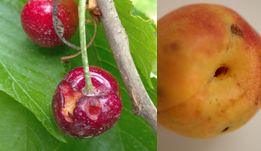
The data were analyzed using a generalized linear mixed model (GLMM) using the package lme4 (Bates et al. 2015), with treatment as a fixed factor and replicate as a random factor, with a binomial error distribution. All data analysis was conducted using the software R, version 4.1.2 (R Core Team 2021).
Objective 2a - Under what conditions can earwigs damage apples?
This subobjective was being altered based on feedback from cooperating growers who thought it would be more useful for us to focus exclusively on 'Honeycrisp'. Additionally, work by cooperator (R. Orpet) in 2020 concluded that pears were at very minimal risk for earwig damage, even if earwigs were placed inside plastic bags with no additional food source. Growers communicating with the grant team have been exclusively concerned about the potential for earwigs to damage 'Honeycrisp' because they are frequently observed within the fruit clusters (likely because this is a very tight clustering variety) and because 'Honeycrisp' is know to be thinner-skinned. We suspected that observed damage to 'Honeycrisp' is because this variety is prone to stem end splits. Earwigs likely exploit the opening caused by the split and expand the damage; however, stem end split apples are usually culled anyway, so if this is what is occurring, earwigs are not causing yield loss.
To assess the potential of earwigs to cause damage to 'Honeycrisp' and whether damage is typically secondary, we tested five treatments in two assays (one in early November and one in early January). The 'Honeycrisp' apples were provided by a grower directly from their storage facility prior to being sent to a packing house, to avoid using waxed apples. The treatments were (1) undamaged fruit, (2) undamaged fruit + alternative food, (3) artificially damaged fruit, (4) artificially damaged fruit + alternative food, and (5) fruit with natural stem end splits. Fruit was artificially damaged by making a shallow 1 inch cut with a knife starting at the base of the stem. The alternative food provided was three pieces of dog kibble. Replicates consisted of a single fruit in a gallon plastic bag with 5 female earwigs and a wet cotton ball provided for moisture. Fruit was assessed for earwig damage periodically over 23 (Assay 1) and 18 days (Assay 2) (evaluation days shown in results graph in "Research results").
The grower who provided the fruit for the experiment noticed a large amount of earwig damage in a block of 'Envy' apples, but suspected that it was secondary following hail damage. She adopted our assay method to assess whether earwig damage was primarily secondary. We provided her with the earwigs and she tested eight treatments: (1) undamaged fruit, (2) undamaged fruit + alternative food, (3) fruit with bitter pit, limb rub, soft spots, (4) Treatment 3 + alternative food, (5) fruit with sunburn cracks and splits, (6) Treatment 5 + alternative food, (7) fruit with hail damage, and (8) Treatment 7 + alternative food. Three replicates were tested for each treatment and earwig damage was assessed at 1, 3, 5, 7, and 12 days.
Objective 2b – Augmentation of earwigs in pome fruit: can we increase earwig populations and reduce pest pressure?
Field sites and experimental design
To determine if introducing earwigs in pome fruit orchards increase their population over time, and if this reduced target pest populations, we mass released and monitored earwigs using standard cardboard traps (Fig. 1). The experiments were conducted in two commercial orchards in Yakima County, WA (apple and pear) and one orchard in Medford, OR (pear) in 2021-2022. The experiment consisted of five replicates, each consisting of a release area with 9 trees (3x3), an intermediate area (6 trees in line, starting from the release area), and a 9-tree control area (3x3) (Fig. 3). Replicates were separated by 30 m to account for possible within-season dispersal of earwigs (Moerkens et al. 2010). Earwigs were always released in the middle tree of the release area. We had two treatments: a continuous release, where we released 100 earwigs every other week during the season, and a mass release of 500 earwigs done early in the season.
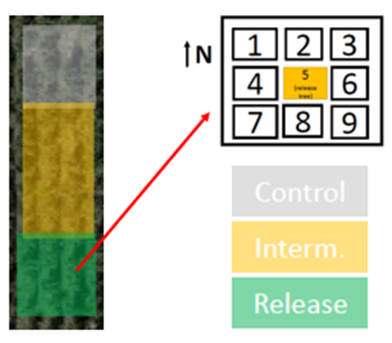
Earwig monitoring
Each individual tree contained one cardboard trap attached slightly under the tree crotch using flagging tape and were monitored once a month. Traps were replaced only if lost or destroyed (e.g., hit by sprinklers or machinery). Traps were checked by emptying them into a bucket, counting earwigs, and then returning them to the same tree. Monthly sampling of earwigs went from June to August each year.
Pest monitoring
We monitored the apple and pear orchards for the presence and abundance of different target pest species every other week, June through August. In the apple orchard, aphids were monitored by examining four random 30-cm shoots per tree and counting the number of infested leaves (green apple aphid, rosy apple aphid) or the number of distinct colonies on the shoot (woolly apple aphid). For pears, we collected 27 leaf samples per plot. Leaf samples were pooled in paper bags, tagged, and taken back to the lab for processing. All pooled leaves were processed using a leaf brush onto a glass plate containing soap. Subsequently, we counted the number of pear psylla (eggs, small nymphs, and large nymphs), twospotted spider mites (eggs and motiles), brown mites (eggs and motiles), European red mites (eggs and motiles), and pear rust mites.
Statistical analysis
Data was analyzed using a generalized linear mixed model (GLMM) using the package glmmTMB (Brooks et al. 2017), with treatment and area (and their interaction) as fixed factors, and replicate and time as random factors, with a negative binomial distribution. All data analysis was conducted using the software R, version 4.1.2 (R Core Team 2021).
Objective 2c - Efficacy of earwig shelters
This subobjective was dropped from the project. It was determined to be too difficult to monitor the earwigs without the use of some form of "shelter trap", confounding the monitoring method with the treatment. The grant team is planning to evaluate commercial earwig shelters in the future. There are now a few of these products available for purchase, primarily in the UK.
Objective 2d - Drone releases of earwigs
In other projects testing drone releases of lacewings and mealybug destroyers, PI Schmidt-Jeffris determined that small scale plots, which were initially planned for this project, were not an effective method of testing drone releases for augmentative biological control. Even with low altitude flights, off-target movement of the released natural enemies is very likely, resulting in no recovery of the natural enemies. Large-scale plots are needed to properly assess whether drone releases can successfully deliver natural enemies to the target; this will be one of the main objectives in an upcoming WSARE submission from Schmidt-Jeffris regarding lacewing release efficacy.
Therefore, this work was instead conducted in Summer 2023 at a USDA-ARS research farm in Moxee, WA. This allowed for the use of four, 1-acre blocks of apples to test drone delivery at a more realistic scale for comparisons to hand releases. First, in Winter 2022, we tested a long-lasting liquid UV paint (Smart Water) and confirmed that two colors (magenta and cartax) could be easily seen on earwigs and did not cause mortality. In preliminary field testing in Fall 2022, we found that the mark lasted on earwigs for over a month in the field.
Earwigs were collected for use early in the season from the commercial cherry orchard used in the trap testing study. Prior to the experiment, earwigs were marked with either magenta or cartax (yellow) SmartWater. Twenty-five cardboard earwig traps were placed evenly throughout the center of the four apple blocks. The day prior to release, M3 calibrated one of their drone delivery devices to release 1,000 earwigs per acre and programmed the flight path. On the release day (26 July 2023), we released 1,000 magenta-marked earwigs in each of four orchard blocks. We then released 1,000 yellow-marked earwigs in the same orchard blocks by hand. We scouted the block for released earwigs at 1 and 7 days post-release. Traps were emptied into a bucket and earwigs were visually examined for the presence of the paint marker using a high intensity UV flashlight.
Objective 3a - Acute short-term toxicity of orchard pesticides to earwigs
The list of planned pesticides to be tested was altered because many of the insecticides and the particle films were tested by co-PI Nottingham as part of a separate project on conserving a variety of natural enemies in pears. Two separate assays were conducted (Assay 1 - insecticide/miticides, Assay 2 - herbicides), each with a water control.
Earwig arenas consisted of glass Petri dishes sprayed with pesticide and air-dried. Pesticides were applied as 2 mL of the appropriate concentration (highest labelled rate) in a Potter Spray Tower. Earwigs were obtained from colonies established with individuals collected in Obj. 1. Five adult females were added to each arena and provisioned with water and dog kibble. There were six arenas (replicates) per treatment. Mortality was recorded at 24 and 48 h. Mortality for each assay was analyzed separately using SAS 9.4 (PROC GLIMMIX), specifying a binomial distribution and a logit link.
Objective 3b - Sublethal effects of pesticides on earwigs
Individuals surviving the mortality assay were placed individually in untreated arenas and recorded with a video camera for 30 min. Time spent moving was monitored using Ethovision XT 14. Earwigs were considered "moving" if their speed was >0.4 cm/s. For each treatment, we monitored up to 10 individuals (replicates) per treatment (fewer if mortality was high - paraquat treatment). In a few cases, individual replicates were excluded from the analysis when the software was unable to detect the earwig in that arena. Logistically, all individuals from an assay could not be observed in the same video. Therefore, within an assay, we ran four (insecticides) or three (herbicides) trials with groups of up to 24 (insecticides) or 26 (herbicides) individuals, with individuals from each treatment represented in each trial. Data from each assay were analyzed separately. Proportion of the total amount of time spent moving was analyzed using SAS 9.4 (PROC GLIMMIX), specifying a binomial distribution and logit link, with "trial" as a random effect.
The next morning after the motion-tracking trial, 10 green peach aphids from colony were added to each earwig arena. The number of consumed aphids was recorded at 30 and 60 minutes (both assays) and at 90 minutes (Assay 2 only). The spinetoram treatment had high mortality overnight, so although there were 10 individuals used in the motion-tracking assay, there are fewer than 10 replicates in this experiment. Several other treatments also had 1-3 individuals die either between the experiments or between evaluation periods during this experiment, resulting in a decreasing number of subjects. Treatments with <3 surviving individuals were not included in the analysis (spinetoram at 60 min, paraquat at all time points). Data from each assay were analyzed separately. Proportion of aphids consumed at each time point was analyzed using SAS 9.4 (PROC GLIMMIX), specifying a binomial distribution and logit link.
Objective 1a – Testing different types of trap to improve earwig capture
Significant findings
- Standard cardboard traps captured the most earwigs
- Leaving the traps throughout the season increased the number of earwigs captured in one of the three field sites tested
Results and Discussion
In 2021, we found that standard cardboard traps captured more earwigs than 0.5L and 2L soda shelter traps at all locations (Fig. 4-6). While soda bottle shelters are commonly used in the UK, it is likely that enclosing the traps in plastic causes them to become too hot in arid central WA. In the UK, the plastic bottle primarily serves as rain protection, which is not necessary in central WA.
In Yakima, changing the trap only monthly or when damaged increased the number of earwigs captured (Fig. 4). These results might be related to the accumulation of aggregation pheromones or cuticular hydrocarbons (Quarrell et al. 2016) within the trap throughout the season, although there were no differences between "monthly" and "weekly" replacement treatments in Wenatchee (2021) or Medford (2021-2022) (Fig. 5-6). It is possible that the traps become "fully saturated" with earwig aggregation pheromone prior to the one week monitoring period, resulting in the trends seen in Wenatchee and Medford. However, the increase in trap catch in Yakima indicates that at least in some locations, the presence of earwig pheromone affect trap catch. Researchers should be aware of this when designing protocols and maintain consistency in how often traps are changed.
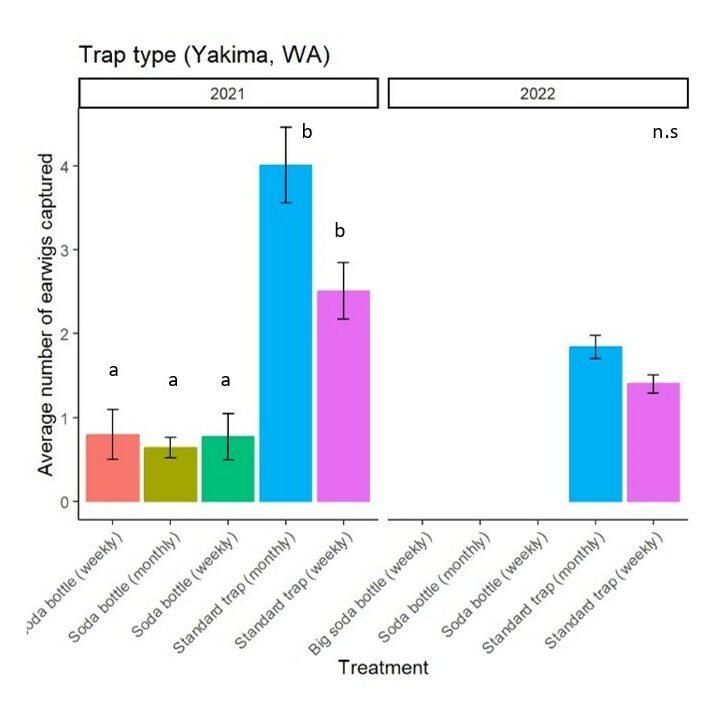
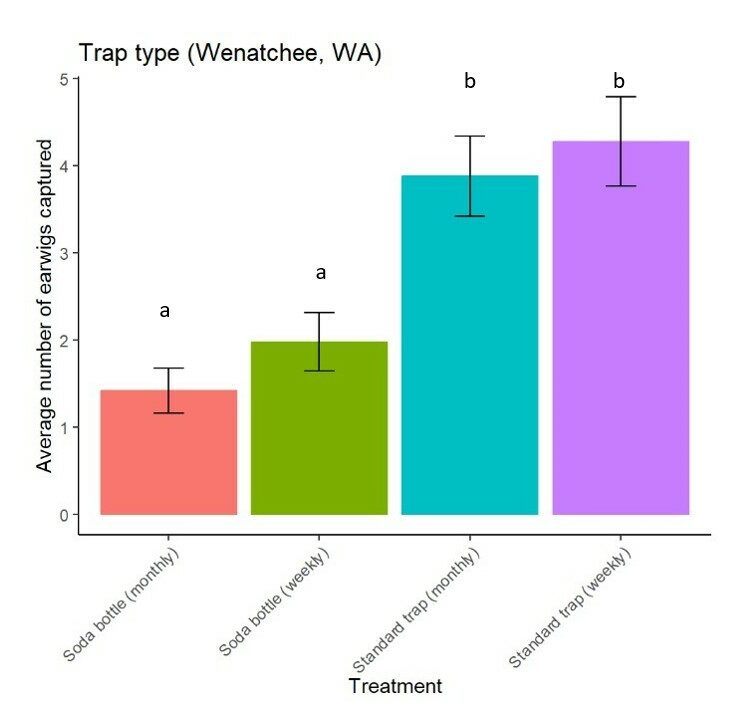
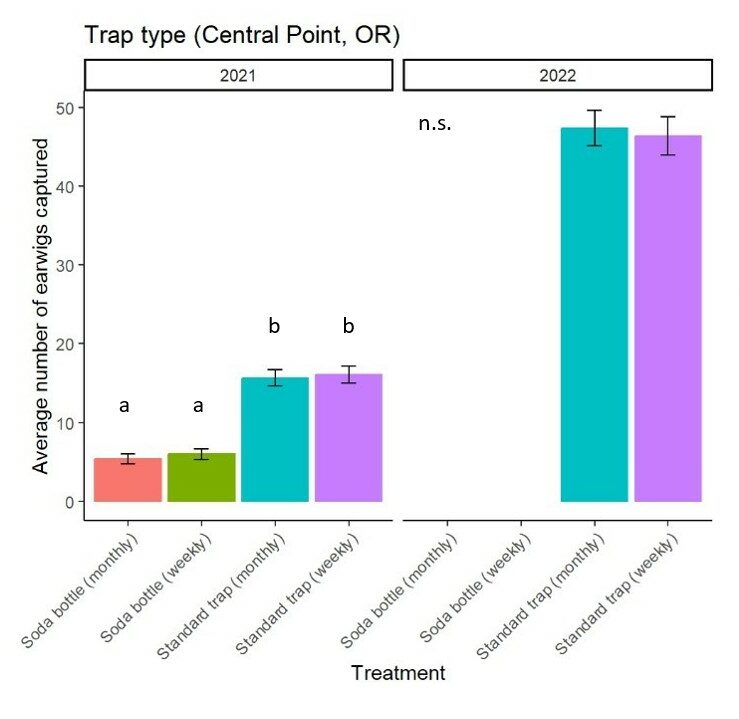
Objective 1b – Mass trapping earwigs where they are pests: does it help reduce earwig populations and fruit damage?
Significant findings
- Mass removal of earwigs in stone fruit did not significantly reduce earwig populations
- Removal of earwigs slightly reduced the observed earwig damage on apricots in 2021 and on cherry in 2022
- Mass removing earwigs at a larger scale and/or for a longer period of time might be successful in decreasing fruit damage, but additional research will be needed to confirm this trend
Results and Discussion
We found that mass trapping and removing earwigs from stone fruit orchards did not significantly reduce earwig populations over time (Fig. 7).
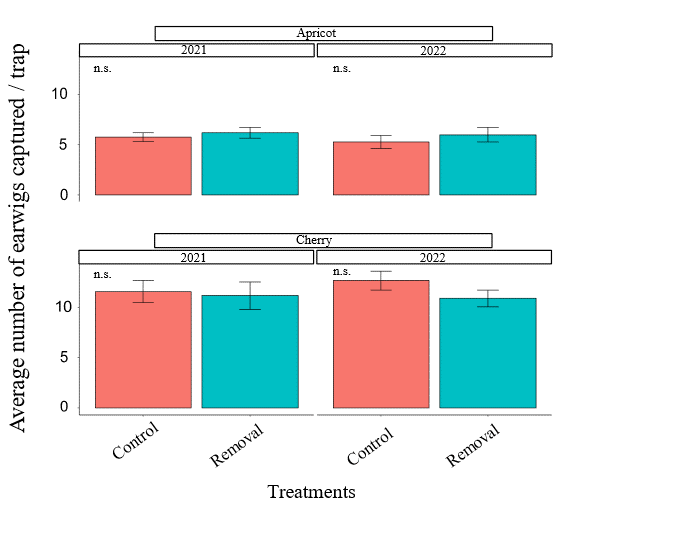
There was a significant reduction in possible earwig damage in apricots in 2021, but not in 2022 (Fig. 8). However, in the apricot orchard in 2021, we were only able to sample fruits after harvest started. This may have affected results by causing us to sample a higher portion of damaged fruits, intentionally left on the tree by pickers. In cherries, we did not observe any significant difference in fruit damage between removal and control plots in 2021, but found weak evidence of damage reduction in 2022 (Fig. 8).

Therefore, mass removal of earwigs using corrugated cardboard traps was not consistently successful in reducing fruit damage for either crop. Future studies are needed to evaluate mass trapping for a longer term, across a larger area to truly determine if this tactic can reduce earwig damage. Although earwigs are poor dispersers, they can likely move into the edges of removal plots, resulting in no observed differences between treatments in our study. Repeating removal across multiple years may also slowly dampen the population, which we may have observed the beginnings of in the cherry orchard in 2022.
Objective 2a - Under what conditions can earwigs damage apples?
Significant findings
- Earwigs are much more likely to damage fruit that has already been damaged, exploiting breaks in the fruit skin
- Earwigs are very unlikely to cause yield loss to apples in the field
Results and Discussion
In both assays, earwig damage to 'Honeycrisp' was lower in the treatments with no previous damage (either artificial or natural stem end splits), regardless of whether alternative food was provided (Fig. 9). When 'Honeycrisp' fruits were previously damaged, providing alternative food decreased the level of earwig damage. While the percent earwig damage in our study (even in the "no damage" treatments) would be considered very unacceptable at pack out, we created a "worst case scenario" by confining earwigs with fruit in plastic bags and still had fruit at the end of the study that were undamaged by earwigs. The risk to 'Honeycrisp' apples is minimal.
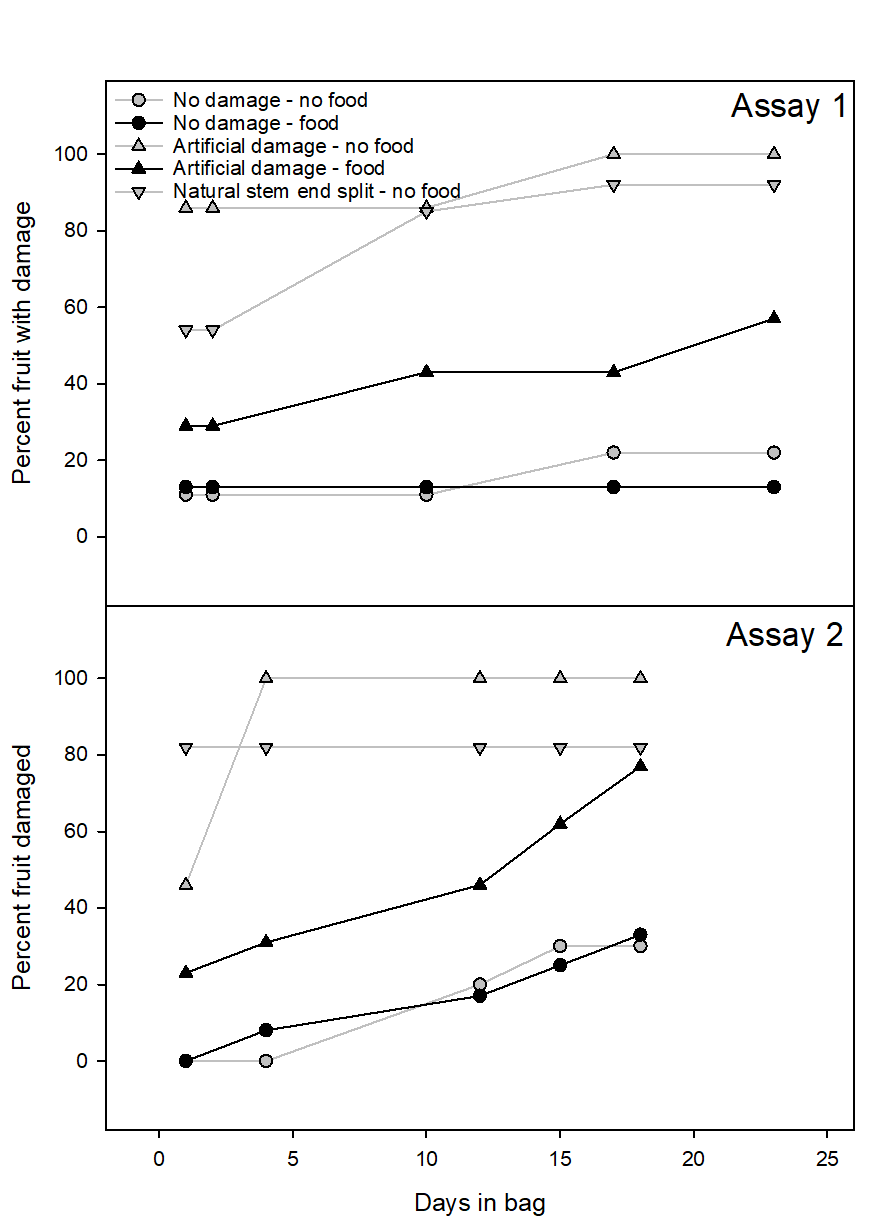
The grower carefully documented the damage to each 'Envy' apple prior to and after introducing earwigs (Fig. 10). Earwigs exploited previous damage to the skin of the fruit and were often found inside hail damage holes (Fig. 10).

The grower summarized the damage to each of the three apples per treatment and provided their summary notes for the last of evaluation (Day 12). Earwigs were most likely to enter the fruit through the calyx or prior damage that caused a break in the fruit skin (Fig. 11). Only one undamaged fruit had earwig-caused damage and this only occurred in the treatment where no alternative food was provided (Fig. 11, second row). In the 24 apples tested, there was only one apple where alternative food was provided and earwig feeding caused damage outside of pre-existing wound (Fig. 11, final row). The grower and the grant team independently concluded that earwigs are unlikely to cause primary damage to 'Envy'. In any future trials assessing earwig damage to apples, researchers should focus on the calyx end of the apple, which appears to be the main point of entry if earwigs cause primary damage. This will also help eliminate the risk of unintentionally counting stem end split damage as earwig damage (opposite end of the apple).
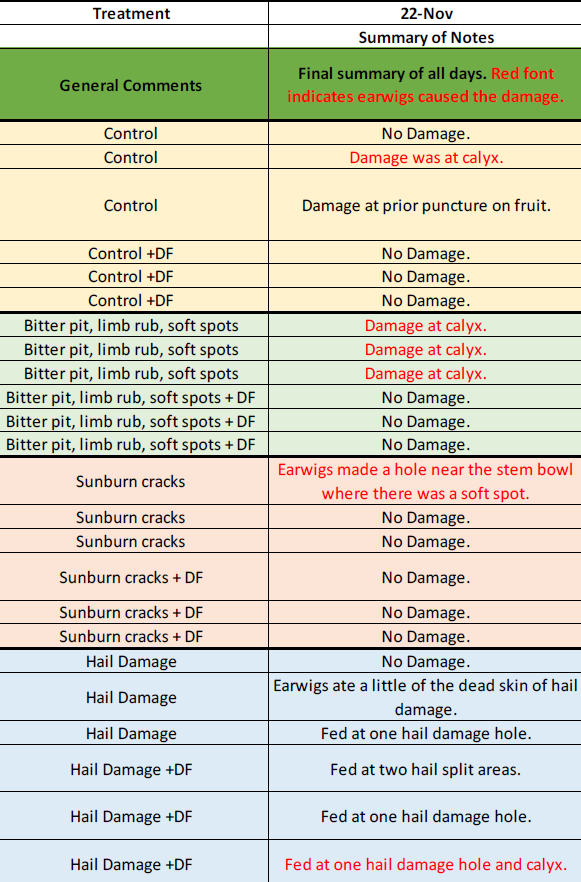
Objective 2b – Augmentation of earwigs in pome fruit: can we increase earwig populations and reduce pest pressure?
Significant findings
- Earwig counts significantly increased after releases, but only in the orchard where they were previously absent
- Earwig releases decreased populations of woolly apple aphid and pear psylla after two years, even in the orchards where they were previously absent
- To our knowledge, this is the first example of deliberately turning a pest into a natural enemy by changing its location
Results and Discussion
Earwig abundance prior to the releases varied between locations. Both apple and pear orchards in WA had high earwig abundance prior to releases, whereas the pear orchard in OR had no earwigs before releases in 2021. In the WA apple orchard, earwig abundance in treated plots, either with one mass release or continuous releases, did not differ from control in 2021 or 2022 (Fig. 12). We observed the same trend in the WA pear orchard (Fig. 12). In the OR pear orchard in 2021, the release treatments had significantly higher earwig abundance compared to control and also differed from each other (Fig. 12). Compared to the control, the mass release had 49× more earwigs and the continuous release had 4× more earwigs. In 2022, there was a low number of earwigs in the OR pear control plots prior to releases beginning that year. There was a significant effect of earwig release treatment in the OR pear orchard in 2022 (Fig. 12). All treatments were significantly different from each other, with continuous releases having overall higher earwig abundance, followed by the mass release, then the control.
Therefore, earwig releases increased earwig abundance within one season, but only in the OR pear orchard where they were absent prior to releases.
In terms of increasing earwig abundance, earwig releases might not be as effective in orchards where earwigs populations are high compared with orchards where they are virtually absent. Orpet et al. (2019) proposed use of earwig augmentation only in pome fruit orchards where earwig populations were low or undetectable because the pest control service provided by additional earwigs have minimal returns where they are already abundant (Nicholas et al. 2005; Dib et al. 2016). In our orchard with low earwig abundance (OR), releases resulted in earwig establishment; they began to be observed in the control plots only after releases began and were found in 2022 prior to the start of releases that year. Given that earwigs were not present in these plots prior to releases in 2021, this likely indicates that earwigs from released plots had begun to move into control plots. Overall numbers in the OR orchard were still very low even after two years of releases (seasonal average of release 1 per trap at most), suggesting that yearly releases might still be needed to achieve thresholds for pest control; it has been suggested greater than two earwigs per trap is correlated with second and third generation biocontrol of pear psylla (DuPont et al. 2023). Another argument in favor of yearly releases in orchards with low earwig abundance is that due to their poor dispersal behavior – moving only up to 30m per month (Moerkens et al. 2010) – earwigs are thought to recolonize areas slowly where they had been absent (Orpet et al. 2019a).

Woolly apple aphid was more abundant than the other two aphid species (green apple and rosy apple aphids) in both years in the WA apple orchard. Woolly apple aphid populations were higher in 2021 than 2022. We observed significant differences in the number of woolly apple aphid colonies between treatments in 2022, but not in 2021 (Fig. 13). In 2022, the mass release treatment had the lowest number of woolly apple aphid colonies, differing significantly from the continuous release, and was marginally different from the control. Numerically, the mass release treatment had 61% fewer woolly apple aphids than the control. Green and rosy apple aphid counts did not differ between treatments in either year of the study (data not shown).
Our results agree with previous studies demonstrating that earwigs can reduce woolly apple aphid populations. Earwig efficacy in controlling woolly apple aphids seems to be highly dependent on factors such as plant architecture, and both current pest, earwig, and other natural enemies’ abundances (Carroll et al. 1985; Mueller et al. 1988; Mols 1996; Quarrell et al. 2017; Orpet et al. 2019). Our results showed that one mass release of earwigs earlier in the season seems to be preferable over multiple releases. This may indicate that earwigs can help prevent aphid population increases, but cannot control high populations (Piñol et al. 2009).
In our study, a possible explanation for no effect of earwigs in suppressing green and rosy apple aphids includes the low overall numbers of these pests in our WA apple orchard. Additionally, green and rosy apple aphids are tended by ants, reducing the efficacy of natural enemies, while woolly apple aphids are not (Minarro et al. 2010).
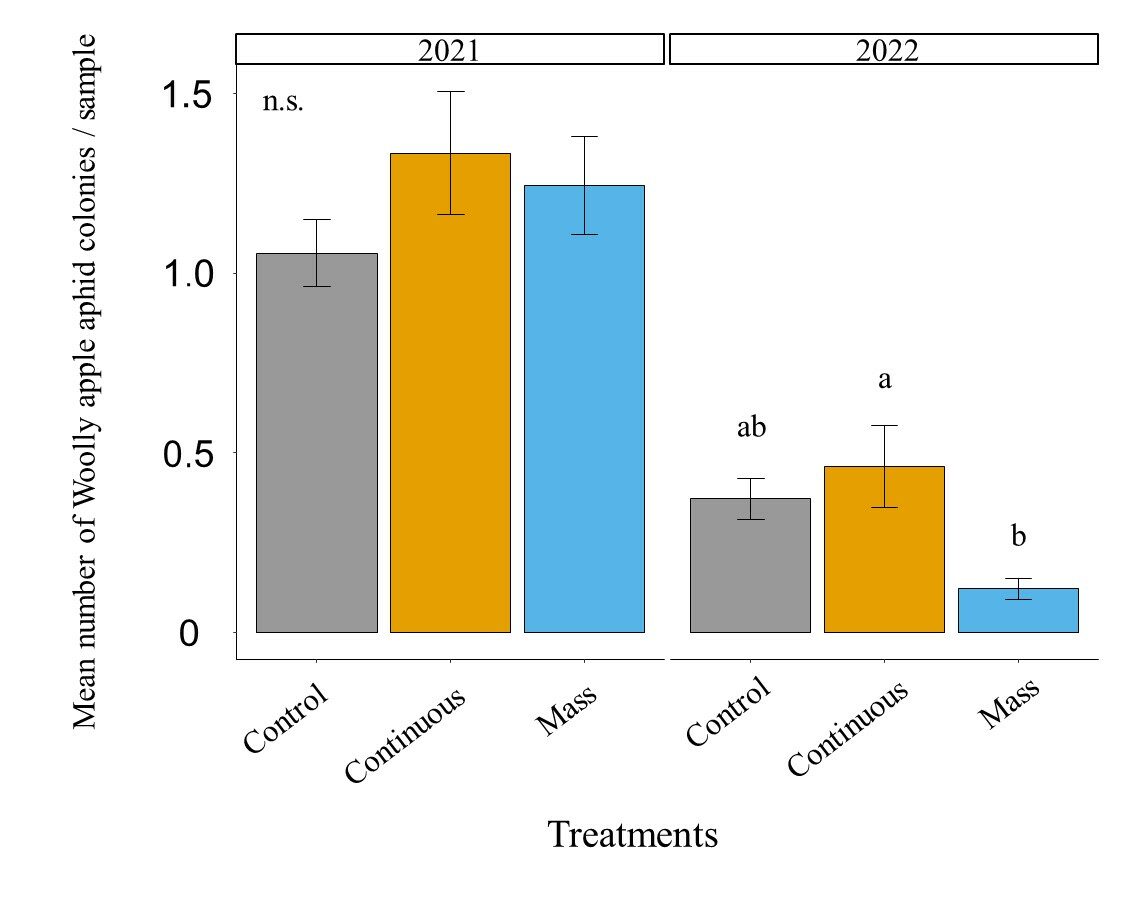
Our results only showed pear psylla reductions after releases in our WA pear orchard and only in 2022 with no significance in the WA pear orchard in 2021, or in OR (Fig. 14). One possible explanation for this could be that the OR pear orchard had consistently low pear psylla abundance, substantially reducing our ability to detect differences in pest levels. In 2022 in OR, although not significant, we did observe a similar trend in our results when compared to what we observed in WA in 2022; there were fewer pear psylla in the mass release treatment compared to the continuous release and the control. It is possible that in an orchard with no earwigs prior to releases (like our OR orchard) but with higher pest densities (like our WA orchard), differences in pear psylla abundance between treatments would be more dramatic.
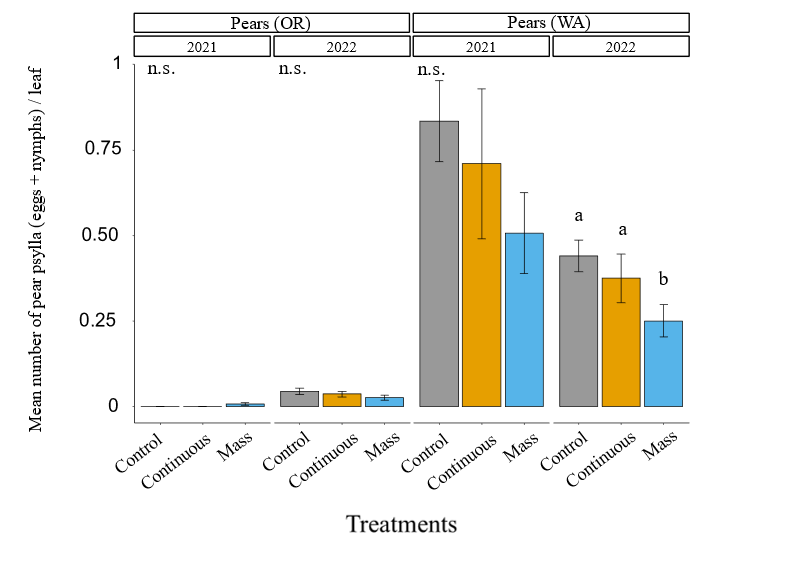
For orchards with either high or low previous earwig abundance, one early-season mass-release seems to be preferable to continuous releases because we observed that a single release early in the season in the OR pear orchard had greater earwig establishment and less pear psylla compared with the continuous release treatment.
Objective 2d - Drone releases of earwigs
Significant findings
- Earwigs have higher recapture rates than many other organisms used in augmentative biological control
- SmartWater provides a long-lasting mark on earwigs that can be easily assessed in the field
- Drone releases of natural enemies require drones with "leak-proof" dispensing canisters and a tight-turn flight path to ensure adequate coverage of an orchard block, which was not accomplished in this trial
Results and Discussion
In the hand-release treatment, 24 and 11 marked earwigs were found 1 and 7 days post-release, respectively (mean of 6 and 2.75 per acre). This represents a recapture rate of 0.6% and 0.3%, respectively. No magenta-marked earwigs were found. In preliminary laboratory trials, the magenta and yellow mark both were detectable far past 1-week post-marking and the paint did not cause substantial mortality, so it is unlikely that these results were caused by differences between the marks. The programmed flight of the drone did not make tight turns throughout the orchard and consequently, missed the center of the block, where sampling occurred. To compare ground and drone releases more accurately, flights will need to ensure adequate coverage of the whole block; this is especially important given that earwigs are slow dispersers. Additionally, there were issues with earwigs rapidly crawling out of the dispensing device as they were being loaded (resulting in a decreased payload once the drone reached the target site). The study should be repeated with a drone that has a closable dispensing device and the earwigs should be chilled prior to loading to prevent this issue in future work.
The trial provided proof-of-concept that earwigs can be used as test organisms for drone-based natural enemy applications. Their rate of recapture is much higher than previous natural enemies tested (e.g., lacewings with 0.008% recapture, Orius insidiosus with 0.08% recapture) making it much easier to compare recovery rates between release methods. Additionally, the trial also showed that SmartWater can be used to mark earwigs and, due to their large size, the presence/absence of the mark can be easily assessed in the field.
Objective 3a - Acute short-term toxicity of orchard pesticides to earwigs
Significant findings
- The insecticides tested are not acutely toxic to earwigs as residues, with the exception of spinetoram
- Of the herbicides tested, paraquat and glufosinate residues were acutely toxic to earwigs
Results and Discussion
None of the insecticide residues tested increased earwig mortality relative to a water control after 48 h of exposure (Table 2). However, in the spinetoram treatment, many earwigs were observed to have died before and during the prey consumption experiment the next day (see Table 6 in Obj. 3b). Therefore, with the exception of spinetoram, the insecticides we tested appear to pose little mortality risk to earwigs if they are exposed to dry residues.
Table 2. Percent mortality of female earwigs confined on fresh, dried insecticide residue at 24 and 48 h (n=6 replicates of 5 earwigs).
| % mortality | ||
| Insecticide | 24 h | 48 h |
| chlorantraniliprole | 0 | 0 |
| cyantraniliprole | 0 | 0 |
| abamectin | 0 | 0 |
| novaluron | 0 | 3 |
| spinetoram | 3 | 7 |
| bifenazate | 0 | 0 |
| fenpyroximate | 0 | 0 |
| spinosad | 0 | 3 |
| control (water) | 0 | 0 |
At 24 h, paraquat was the only herbicide with significantly higher mortality than the control (Table 3). At 48 h, glufosinate also significantly differed from the control and mortality of earwigs exposed to paraquat increased (and remained different from the control and the other herbicides). Paraquat and glufosinate residues are appear to be highly toxic to earwigs.
Table 3. Percent mortality of female earwigs confined on fresh, dried herbicide residue at 24 and 48 h (n=6 replicates of 5 earwigs).
| % mortality | ||
| Herbicide | 24 h | 48 h |
| glufosinate | 0b | 47b |
| rimsulfuron | 0b | 3c |
| halosulfuron | 3b | 7c |
| oxyfluorfen | 3b | 7c |
| 2,4-D | 0b | 3c |
| glyphosate | 7b | 17c |
| paraquat | 67a | 83a |
| control (water) | 0b | 0c |
Objective 3b - Sublethal effects of pesticides on earwigs
Significant findings
- Insecticides: novaluron and bifenazate residue exposure caused increased movement in earwigs, whereas chlorantraniliprole, cyantraniliprole, and fenpyroximate caused decreased movement. Spinetoram, spinosad, and cyantraniliprole exposure caused reduced prey consumption.
- Herbicides: glufosinate and halosulfuron exposure caused increased movement. All herbicides reduced prey consumption, but the effect was greatest in the rimsulfuron treatment. (paraquat excluded from prey consumption effects study due to high mortality)
- Of the insecticides tested, spinetoram and cyantraniliprole appear to the most at risk to disrupt earwig biocontrol in the field, but spinosad may also be of concern.
- Of the herbicides tested, paraquat, glufosinate, and rimsulfuron are the most likely to disrupt earwig biocontrol, but all herbicides showed the potential for reducing earwig prey consumption. Glufosinate and paraquat are used as burndown herbicides and are increasing in use by growers due to consumer concerns about glyphosate. Our results (and other studies, Zilnik et al. 2023) indicate that the substitution of paraquat or glufosinate for glyphosate has a high risk for disrupting biocontrol in agroecosystems.
Results and Discussion
In general, earwigs spent very little of their time moving, which is expected for a nocturnal predator tested in lighted conditions. Overall, earwigs in the first assay (Table 4) appeared to be more active than those in the second assay (Table 5). Relative to the control, novaluron and bifenazate had increased earwig activity, whereas chlorantraniliprole, cyantraniliprole, and fenpyroximate had decreased earwig activity; the other insecticide/miticides did not differ from the control (Table 4).
Increased movement after pesticide exposure can indicates an irritant effect or a decreased level of motor coordination that results in rapid, but uncoordinated movements. Decreased movement can indicate that the insect is moribund and near death, but insects can also recover over time. Both increased and decreased movement would likely impact the ability of earwigs to effectively hunt pests in the field.
Table 4. Percent of time spent moving (>0.4 cm/s, out of 30 min) by female earwigs after 48 h of exposure to insecticide residues. Treatments followed by the same letter are not statistically different (p<0.05, lsmeans).
| Insecticide | n | % time moving |
| chlorantraniliprole | 10 | 0.37c |
| cyantraniliprole | 9 | 0.19cd |
| abamectin | 9 | 0.74b |
| novaluron | 10 | 1.84a |
| spinetoram | 10 | 0.97b |
| bifenazate | 9 | 1.87a |
| fenpyroximate | 10 | 0.10d |
| spinosad | 10 | 1.07b |
| control (water) | 10 | 0.78b |
Glufosinate and halosulfuron increased earwig movement relative to the control; no other herbicides differed from the control (Table 5).
Table 5. Percent of time spent moving (>0.4 cm/s, out of 30 min) by female earwigs after 48 h of exposure to herbicide residues. Treatments followed by the same letter are not statistically different (p<0.05, lsmeans).
| Herbicide | n | % time moving |
| glufosinate | 10 | 0.26a |
| rimsulfuron | 10 | 0.11abc |
| halosulfuron | 10 | 0.29a |
| oxyfluorfen | 10 | 0.12ab |
| 2,4-D | 8 | 0.12ab |
| glyphosate | 10 | 0.03c |
| paraquat | 4 | 0.01c |
| control (water) | 9 | 0.08bc |
At 30 min, spinetoram and spinosad exposed earwigs had reduced prey consumption relative to the control. Spinetoram results could not be included in the analysis at 60 min because at that point there were only 2 surviving individuals. At 60 min, cyantraniliprole and spinosad had reduced prey consumption relative to the control, with a greater reduction in spinosad compared to cyantraniliprole.
Table 6. Percent of green peach aphid prey consumed (out of 10) by a female earwig after 48 h of exposure to insecticide residues at 30, 60, and 90 minutes after providing the aphids. Treatments followed by the same letter are not statistically different (p<0.05, lsmeans).
| 30 min | 60 min | |||
| Insecticide | n earwigs | % prey consumed | n earwigs | % prey consumed |
| chlorantraniliprole | 10 | 68a | 10 | 89ab |
| cyantraniliprole | 10 | 55a | 10 | 72c |
| abamectin | 10 | 55a | 10 | 92a |
| novaluron | 10 | 58a | 10 | 82abc |
| spinetoram | 4 | 23b | 2 | - |
| bifenazate | 10 | 61a | 10 | 80bc |
| fenpyroximate | 10 | 60a | 10 | 92a |
| spinosad | 10 | 38b | 8 | 54d |
| control (water) | 10 | 60a | 10 | 90ab |
At 30 min, glufosinate, 2,4-D, halosulfuron, and oxyfluorfen had reduced prey consumption compared to the control, but not rimsulfuron or glyphosate. At 60 min only rimsulfuron did not differ from the control and at 90 min all herbicide treatments differed from the control. Halosulfuron caused the greatest reduction in prey consumption; glyphosate, rimsulfuron, and glufosinate had the least reduction in prey consumption, and oxyfluorfen and 2,4-D were intermediate.
Table 7. Percent of green peach aphid prey consumed (out of 10) by a female earwig after 48 h of exposure to insecticide residues at 30, 60, and 90 minutes after providing the aphids. Treatments followed by the same letter are not statistically different (p<0.05, lsmeans).
| 30 min | 60 min | 90 min | ||||
| Herbicide | n earwigs | % prey consumed | n earwigs | % prey consumed | n earwigs | % prey consumed |
| glufosinate | 8 | 44bcd | 8 | 56bc | 8 | 66b |
| rimsulfuron | 10 | 57ab | 10 | 70ab | 10 | 71b |
| halosulfuron | 9 | 29d | 9 | 38d | 9 | 43c |
| oxyfluorfen | 9 | 30d | 9 | 52cd | 9 | 57bc |
| 2,4-D | 9 | 42cd | 9 | 56bc | 9 | 57bc |
| glyphosate | 10 | 56abc | 10 | 69b | 10 | 78b |
| control (water) | 10 | 68a | 10 | 82a | 10 | 89a |
Research Outcomes
Education and Outreach
Participation Summary:
Completed Outreach
Presentations by the numbers:
| Presentation Type | # of Presentations | Total Attendance |
| Grower/Consultant meeting | 19 | 1395 |
| Workshop/Field Day/Tour | 5 | 149 |
| National conference | 7 | 430 |
| Regional conference | 4 | 110 |
| Academic Seminars/Other | 5 | 117 |
Consultations:
Consultations are primarily emails and phone calls from growers and crop consultants to R. Orpet, A. Hanel, and R. Schmidt-Jeffris regarding how to best trap and move earwigs or regarding sprays that are minimally harmful to earwigs. There have also been a few on-farm visits to view grower “trap and move” programs, which included recommendations for better trap placement to increase catch.
Curricula, factsheets or education tools:
See “New Grant” subsection at the end of this section, which has produced two factsheets and a website for the project funded by the new grant (SARE Research to Grassroots, R. Orpet lead). Some of the data summarized in the pesticide non-target effects data sheet were generated from this project, Obj. 3.
Website: https://cahnrs.wsu.edu/tfrec-orpet/earwigs/
Factsheets:
Orchard Pesticide Safety for Earwigs (https://s3.wp.wsu.edu/uploads/sites/3153/2023/07/ETW1_pesticidesafety_v1.1.pdf)
Guide to Earwig Transportation (https://s3.wp.wsu.edu/uploads/sites/3153/2023/07/ETW2_earwigscareguide_v1.1.pdf)
Journal articles:
All articles are chapters of project-funded Ph.D. student Aldo Hanel’s dissertation work. One article (below) was accepted as part of a special issue on tree fruit biological control in the journal Insects, while the rest are in preparation. All in preparation articles are complete drafts currently being reviewed by his dissertation committee/coauthors. He will be defending his dissertation in April 2024.
Published:
Hanel, A., Orpet, R.J., Hilton, R., Nottingham, L., Northfield, T.D., Schmidt-Jeffris, R. Turning a pest into a natural enemy: Removing earwigs from stone fruit and releasing them in pome fruit enhances pest control. Insects. 14(12), 906.
In-prep:
Non-target effects of pesticides commonly used in orchards on the European earwig, a key natural enemy. Target journal: Journal of Economic Entomology
Evaluating trapping methods to increase European earwig (Dermaptera: Forficulidae) capture in temperate tree fruit crops. Target journal: Journal of Economic Entomology
Earwig gut content analysis: what works and what doesn’t. Target journal: Biocontrol Science and Technology.
Workshop/field days:
(these are also on-farm demonstrations, but we have only counted them under the workshop/field days category)
Earwig-specific workshop, 12 July 2023
This workshop was held as part of the newer WARE Research to Grassroots grant described in “New Grant” subsection below (lead PI Orpet). Project-funded student Hanel assisted with the workshop, including trapping the earwigs that were distributed. Stakeholders (growers, managers, consultants) representing eight pear-growing operations and one apple-growing operation participated in the workshop in 2023. Each person received a free bucket containing >500 earwigs, observed a demonstration of earwig collection, and received educational handouts. In a post-workshop survey, 22% of attendees said they had previous experience monitoring earwigs, 44% said they knew whether their pesticide programs were earwig-safe, and none had transported earwigs before. After the workshop, 100% of attendees said that in 2024 they plan to do all of the following: monitor earwigs with cardboard, modify a spray program to be earwig-safe, improve the advice they give to other producers or professionals, and increase their networking with other professionals. There were 14 attendees, including three children (growers brought family members) and a reporter.
Orpet, RJ. 2022. Outcomes of the pear psylla phenology project this season. Washington State University Pear Psylla Field Day in Peshastin WA, Sept 21. 25 growers and 5 other stakeholders were in attendance. Earwigs as biocontrol agents of pear psylla and impacts of spray choice/timing on natural enemies was discussed.
Hanel, A. 2022. Earwig release research overview, using one of the study sites from the project (see previous). Pear Field Day in Central Point, OR on July 7. 25 attendees.
Hilton, R. 2021. Earwig release study site was used as a stop on the Pear Field Day in Central Point, OR on July 15th. Pear psylla biological control and the potential of earwigs as natural enemies was discussed. The use of rolled cardboard traps was demonstrated. 10 growers and 15 consultants/ag professionals were in attendance. Both southern Oregon growers participating in the research were in attendance and discussed their experiences with trapping and moving earwigs.
Newsletters:
Orpet, R. 2023. Woolly apple aphid management in 2023. Washington State University Tree Fruit Matters. May: https://treefruit.wsu.edu/article/woolly-apple-aphid-management-in-2023/
Catron, K. 2023. Rally the troops: free earwigs to be distributed to pome fruit growers at TFREC workshop. Washington State University Tree Fruit Matters. June: https://treefruit.wsu.edu/article/rally-the-troops-free-earwigs-to-be-distributed-to-pome-fruit-growers-at-tfrec-workshop/
Press coverage:
Billingham, E. 2023. Perfecting Eden's fruit takes geneticists, AI, and some earwigs. Inlander. https://www.inlander.com/food/perfecting-edens-fruit-takes-geneticists-ai-and-some-earwigs-26790559 (Regional Outlet)
Schlossberg, 2023. The science of farming. A Changing Planet. https://changingplanet.substack.com/p/news-from-a-changing-planet-43-the (Blog)
Skernivitz, T. 2023. Earwigs in the orchard: Bad for cherry growers, but good for pome fruit growers. Growing Produce. https://www.growingproduce.com/fruits/earwigs-in-the-orchard-bad-for-cherry-growers-but-good-for-pome-fruit-growers/ (National Outlet)
Temin, T. 2023. This USDA entomologist lets bugs do the dirty work of eliminating other bugs. The Federal Drive - Federal News Network. https://federalnewsnetwork.com/workforce/2023/10/this-usda-entomologist-lets-bugs-do-the-dirty-work-of-eliminating-other-bugs/ (Radio Interview)
Tours:
Field tour held 8-10 May 2022, sponsored by the Entomological Society of America and led by Schmidt-Jeffris. 55 attendees included entomologists, orchardists, viticulturists, beneficial insect producers, and crop consultants. The group discussed the future of biocontrol in perennial crops and included using earwigs as part of the discussion. Participants included local stakeholders, but also researchers from across the U.S. who came to learn more about the unique challenges and opportunities in this cropping system, and to discuss parallels with their research.
Webinars/talks/presentations:
Schmidt-Jeffris, R. Pear psylla natural enemies: Biology and conservation. Willbur-Ellis Grower Meeting. 9 December 2023, Wenatchee, WA. 40 attendees, primarily growers/consultants. (Regional Meeting)
Schmidt-Jeffris, R., Moretti, E., Hanel, A. Poster. Getting into the weeds: Herbicide non-target effects research updates and challenges. Symposium: Non-target Effects of Pesticides: Natural Enemies, Pollinators, and More. Entomological Society of America National Meeting. 5-8 November 2023, National Harbor, MD. Interactive poster symposium. 50 attendees. (National Meeting)
Hanel A, Orpet R, Hilton R, Nottingham LB, Northfield T, Schmidt-Jeffris R (2023) Non-target and sublethal effects of pesticides on the European earwig, Forficula auricularia L. Entomological Society of America National Meeting, National Harbor, MD. Oral presentation. 30 attendees. (National Meeting)
Schmidt-Jeffris, R. Biological control research updates in tree fruit: augmentation, earwigs, and pesticide non-target effects. New Zealand Technology Immersion Tour – group of agritech business representatives, orchardists, and government agency employees from New Zealand, hosted by the Washington Tree Fruit Research Commission. 11 September 2023, Wapato, WA. 20 attendees. (International)
Orpet, RJ. 2023. Pesticides in IPM: pear psylla. Entomological Society of America Pacific Branch Meeting in Seattle, WA. 30 attendees. (Regional Meeting)
Hanel, A. 2023. One omnivore to rule them all: augmentation of earwigs increases control of pear psylla, aphids, and mites in pome fruit orchards. Entomological Society of America Pacific Branch Meeting in Seattle, WA. 30 attendees. (Regional Meeting)
Orpet, RJ. 2023. Pear psylla phenology and management. Decision Aid System workshop webinar, April 14. 2 growers and 5 other stakeholders attended. (State Meeting)
Orpet, RJ. 2023. IPM strategy for pear psylla. Hi-Up growers meeting, Peshastin, Feb 22. 15 growers and 3 other stakeholders attended. (Local Meeting)
Orpet, RJ. 2023. Chemical effects on pear natural enemies and management outcomes. Northwest Wholesale Incorporated Wenatchee Growers Meeting, Wenatchee, Feb 21. 50 growers and 10 other stakeholders attended. (Local Meeting)
Hanel, A. 2023. Oregon State University Hood River Winter Hort Meeting. Feb 8. 24 growers and 20 other stakeholders. (State Meeting)
95% of attendees learned something new about earwigs. Three had recently tried trapping and moving earwigs. Of growers/consultants attending, 88% were very likely or somewhat likely to implement something they learned from the earwig presentation.
Orpet, RJ. 2023. Integrated pest management and how it works for pear psylla and mites. Okanogan Horticultural Association Annual Meeting, Feb 7. 40 growers and 8 other stakeholders attended. (Local Meeting)
Orpet, RJ. 2023. Pear psylla control and IPM programs. Northwest Wholesale Incorporated Omak Growers Meeting, Omak, Feb 2. 50 growers and 10 other stakeholders attended. (Local Meeting)
Orpet, RJ. 2023. Pear psylla integrated pest management. Northwest Wholesale Incorporated Cashmere Growers Meeting, Cashmere WA, Jan 31. 40 growers and 10 other stakeholders attended. (Local Meeting)
Orpet, RJ. 2023. Integrated pest management and how it works for pear psylla. 76th Annual Lake Chelan Horticultural Meeting, Chelan WA, Jan 21. 40 growers and 10 other stakeholders. (Local Meeting)
Hanel, A. 2023. Earwigs provide control of aphids, mites, and pear psylla in pome fruit. Orchard Pest Management and Disease Conference. Portland, OR, 11-13 Jan. (National Meeting)
Two presentations at North Central Washington Tree Fruit Days Pear Day. 2023. Orpet, R.J. Phenology-based integrated pear pest management step by step and Schmidt-Jeffris, R. Potential and best management practices for natural enemy releases. Wenatchee WA, Jan 19. 500 growers and 50 other stakeholders attended. (State Meeting, but many out-of-state attendees attend virtually, including some international attendees)
Online participants only, poll question: Did you learn something about earwigs from this talk that you didn’t know previously? 88% yes (n=109)
Orpet, RJ, D Crowder, V Jones, and LB Nottingham. 2022. Aphid video surveillance for biocontrol research and extension. Entomological Society of America Annual Meeting in Vancouver, Canada. Invited talk. 30 attendees. (International Meeting)
Hanel A. 2022. Out-n-in insects: Earwigs as pests and natural enemies in temperate tree fruit orchards in the Pacific Northwest, USA. Entomological Society of America National Meeting, Vancouver, BC. Oral presentation. 30 attendees. (International Meeting)
Orpet RJ. 2022. Working with insects and people for sustainable agriculture. Washington State University Department of Entomology Hyde Seminar Series, 22 Aug. 30 attendees. (Local Meeting)
Orpet, RJ. 2022. Combining insects and people with integrated pest management research in Washington State pear. Entomological Society of America Pacific Branch Meeting in Santa Rosa, CA. 30 attendees. (Regional Meeting)
Hanel, A. 2022. Back to basics: the dual role of earwigs in tree fruit orchards. Pacific Branch - Entomological Society of America Annual Meeting, 10-13 April 2022, Santa Rosa, CA. 20 attendees. 30 attendees. (Regional Meeting)
Two presentations at Pear IPM Intensive held by WSU Extension: Orpet, RJ. Phenology-based integrated pear pest management step by step and Schmidt-Jeffris, R. What’s New – New Research Panel. 14 December, Wenatchee, WA. 70 in person and 133 online attendees. (State Meeting, some out-of-state attendees)
WSU extension (Tianna DuPont) conducted an evaluation of the training:
A Pear IPM Intensive fruit school December 14, 2022 provided two hundred and three participants (70 in person and 133 online) with in-depth pear integrated pest management information. 89% of participants reported learning a good or great deal from the workshop (N=91). For example, participants reported learning: 'new psylla and natural enemy thresholds', 'not all particle films are the same,' 'importance of honeydew washing', 'lots of tips or washing,' 'research on psylla mating disruption [with vibrations]', 'which insecticides to avoid', and more. 86% of participants planned to implement new practices based on the workshop (N=69). For example, participants planned to, 'integrate scouting to time sprays,' install overhead washing', 'use beneficial friendly sprays,' 'push more Surround early,' 'use thresholds to help in the decision process,' 'earlier application of Surround' and more.
Orpet, RJ. 2022. IPM in Pear. NW Hort Expo, Wenatchee WA, Dec 6. 50 growers and 5 other stakeholders attended. (State Meeting)
Orpet RJ. 2022. Pear psylla in our valley: 70 years of effort towards sustainable integrated pest management. Science in Our Valley Seminar Series, Wenatchee WA, Oct 12. 15 attendees. (Local Meeting)
Hanel A. 2022. The dual role of earwigs in temperate tree fruit orchards: What do we know and what is the way forward? Orchard Pest and Disease Management Conference, Portland, OR. Oral presentation. 100 attendees, some growers. (National Meeting)
Orpet, RJ. 2021. Replace some insecticides with reflective mulch and earwigs in industrial pear psylla management? USDA-ARS Wapato Seminar Series, 3 Dec. 20 attendees. (Local Meeting)
Orpet, RJ, and L Nottingham. 2021. Integrating European earwig inoculation with spray programs for pear psylla pest management in commercial orchards. Entomological Society of America National Meeting in Denver, CO. 20 attendees. (National Meeting)
Orpet, RJ and ST DuPont. 2021. Scouting for integrated pest management in pear in the field. North Central Washington Fieldmen Association meeting, Jun 17. 20 attendees. (Local Meeting)
Orpet, RJ. 2021. Phenology models and other best practices for tree fruit pest management. Washington State Department of Agriculture Pesticide Stewardship Program Workshop, Mar 18 (Cashmere) and Mar 19 (Okanogan) (virtual). 40 attendees. (Local Meeting)
Orpet, RJ and L Nottingham. 2021. Integrated pear psylla management: biological, cultural, and chemical. Medford (OR) Pear Growers Meeting, Jan 28 (virtual). 30 attendees. (Local Meeting)
Orpet, RJ and L Nottingham. 2021. Suppressing pear psylla while conserving natural enemies is the key to success. Wilbur Ellis Washington Grower Meeting, Jan 7 (virtual). (Local Meeting)
Schmidt-Jeffris. Recruiting and retaining arthropod allies for pest control in tree fruit. University of North Florida. 1 October 2021, Virtual. 30 attendees. (Out-of-state, local audience)
Schmidt-Jeffris. Save what you have, add some more if you don’t have enough: conserving and augmenting natural enemies in tree fruit. University of Nebraska-Lincoln. 24 September 2021, Virtual. 22 attendees. (Out-of-state, local audience)
Hanel, A., Orpet, R., Hilton, R., Nottingham, L., Schmidt-Jeffris, R. Does mass trapping earwigs in stone fruit orchards affect yield and fruit damage? Entomological Society of America 69th Annual Meeting, 31 October-3 November 2021, Denver, CO. 20 attendees. (National Meeting)
Hanel, A. 2021. Earwigs as Biological Control Agents in Temperate Tree Fruit Orchards: What Do We Know and What is the Way Forward. 95th Annual Orchard Pest and Disease Management Conference, 12-14 January, Portland, OR. 100 attendees (some growers, but data not collected) (National Meeting)
Sijn van Laer (guest speaker from the Netherlands). 2021. Be BRAVE Sustainable control of pear psylla. Seminar for OSU extension. Included information about the role of earwigs as biocontrol agents in European orchards. Available online, over 200 views: https://www.youtube.com/watch?v=B0E0gyhONuc (State Meeting, some out-of-state and international attendance)
Other educational activities:
Biological control stakeholder focus groups held in Wenatchee, Yakima, and Okanogan (WA) and Medford and Hood River (OR). Earwigs as biological control agents were mentioned in each discussion. Over 60 participants, which included growers, crop consultants, and extension specialists.
The project was used as a training opportunity in partnership with Yakima Valley College. In the summers of 2021 and 2022, two interns from the Summer Undergraduate Research Experience (SURE) were mentored by the WSARE project-funded Ph.D. student, Aldo Hanel. The interns assisted with data collection for a portion of the project (mass trapping and releasing earwigs). They also learned how to summarize data and present a research talk and poster. The interns working on the project in 2022 were mentioned in the local newspaper: https://www.yakimaherald.com/news/local/education/yvc-students-gain-educational-career-benefits-during-summer-research/article_a3eea50f-c07d-5f1b-8c83-0d2fb7d19e2e.html. The 2021 interns were featured in the Yakima Valley College Voice magazine: https://www.yvcc.edu/magazine/student-research-accelerate-education/.
New Grant:
Because of the results of this project, we determined that the best use case for earwig releases is in orchards that have recently transitioned to “soft IPM” or organic, where previous spray programs may have eliminated them. Grant collaborator Robert Orpet successfully submitted a WSARE Research to Grassroots grant to expand the extension efforts related to earwig trap and release, “Supporting transition to integrated pest management in pear and apple with education and training in European earwig releases”. The objectives of this project are (1) increase knowledge of how to successfully integrate biocontrol in pear and pest management, especially in the role of European earwigs and how to conserve them, (2) Facilitate and train tree fruit professionals to monitor, collect, and transport earwigs to inoculate orchards lacking earwigs and increase biocontrol services, and (3) Increase the number of pear and apple acres using IPM by facilitating the documentation of outcomes and sharing of results. A series of workshops will be held that include directions for how to release earwigs, handouts describing conservation and releases, and “earwig give away kits” with live earwigs for growers to try releasing themselves.
Some outreach efforts from the first year of the Research to Grassroots grant are also reported here, but will be presented in more detail in the reports for that project.
Results from specific outreach activities (survey results) are presented in "Education and outreach methods and analyses".
We have had several growers individually tell us that they released earwigs in 2022-2023. As an example success story, one large Yakima Valley pear grower reported using an "earwig trapping team" to place traps this spring. The grower consulted Schmidt-Jeffris in early 2023 regarding the size of traps to use and brought in samples of the traps they were making to confirm that he was making them correctly. The traps and team are shown in these photos, with the permission of the grower on the condition of remaining unnamed.
PI Schmidt-Jeffris was recognized as a 2023 Finalist for the Emerging Leader category of the Service to America Medals, which recognizes career federal employees across all agencies. The award was for "engaging in pioneering work that deploys insects as natural predators against other bugs that damage crops such as apples and pears, limiting the use of harmful pesticides, saving farmers money and protecting the environment," including the work from this project on earwig releases. This resulted in media coverage of the earwig project, and other natural enemy release projects being conducted by the Schmidt-Jeffris lab (https://servicetoamericamedals.org/honorees/rebecca-schmidt-jeffris/).
Education and Outreach Outcomes
In general, growers liked the "hands on" components of outreach activities and that earwigs are a "do it yourself" pest control method. Because of their size (easily visible, easy to identify) and the ease of using and building earwig traps, growers were able to quickly implement recommendations.
The on-farm demonstrations were also useful in showing other growers that these tactics were viable and being used by their colleagues.
- The role of earwigs in orchard pest management
- How to monitor for earwigs
- How to trap and move earwigs for pest control
- How to conserve earwigs through selective pesticide use
